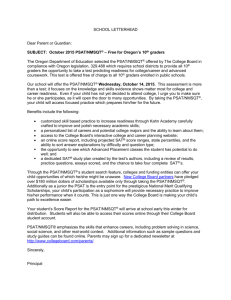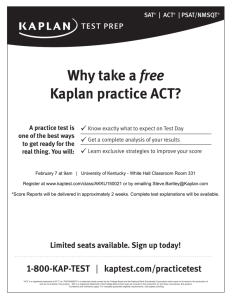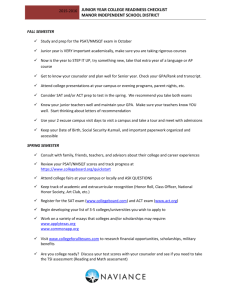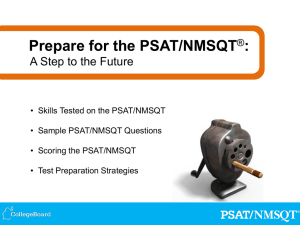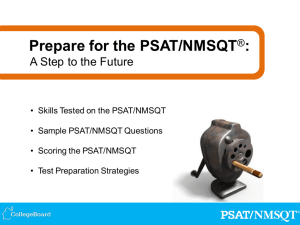PRESENTER NOTES: PSAT lesson on January 15th 2013
advertisement
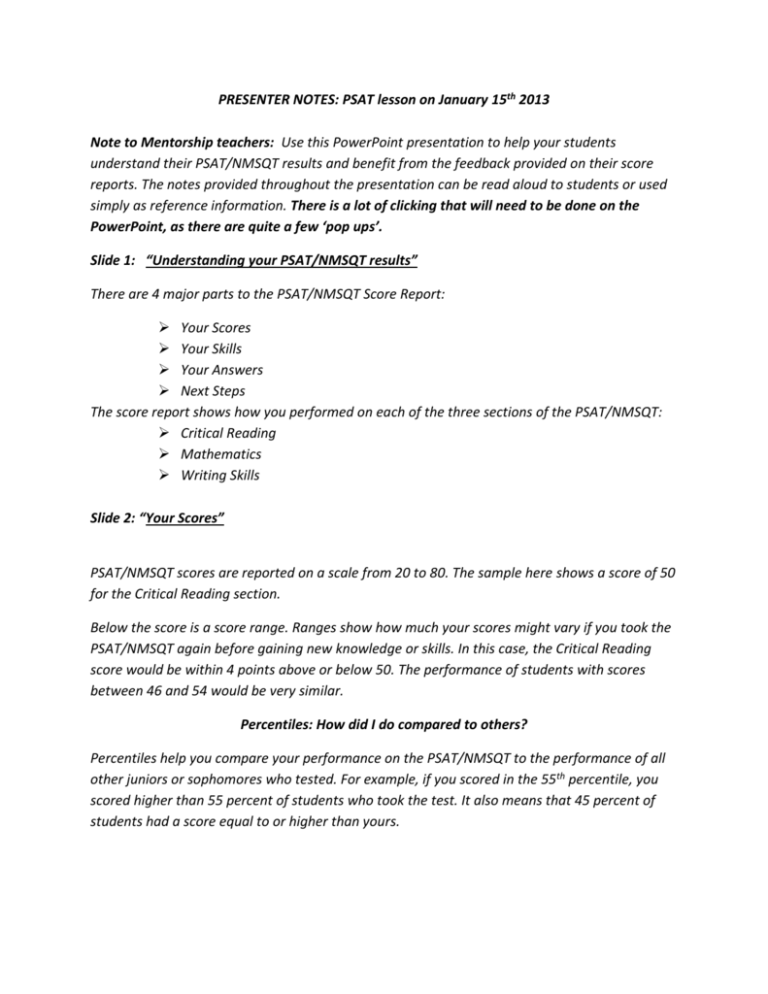
PRESENTER NOTES: PSAT lesson on January 15th 2013 Note to Mentorship teachers: Use this PowerPoint presentation to help your students understand their PSAT/NMSQT results and benefit from the feedback provided on their score reports. The notes provided throughout the presentation can be read aloud to students or used simply as reference information. There is a lot of clicking that will need to be done on the PowerPoint, as there are quite a few ‘pop ups’. Slide 1: “Understanding your PSAT/NMSQT results” There are 4 major parts to the PSAT/NMSQT Score Report: Your Scores Your Skills Your Answers Next Steps The score report shows how you performed on each of the three sections of the PSAT/NMSQT: Critical Reading Mathematics Writing Skills Slide 2: “Your Scores” PSAT/NMSQT scores are reported on a scale from 20 to 80. The sample here shows a score of 50 for the Critical Reading section. Below the score is a score range. Ranges show how much your scores might vary if you took the PSAT/NMSQT again before gaining new knowledge or skills. In this case, the Critical Reading score would be within 4 points above or below 50. The performance of students with scores between 46 and 54 would be very similar. Percentiles: How did I do compared to others? Percentiles help you compare your performance on the PSAT/NMSQT to the performance of all other juniors or sophomores who tested. For example, if you scored in the 55th percentile, you scored higher than 55 percent of students who took the test. It also means that 45 percent of students had a score equal to or higher than yours. Another way to understand percentiles is to visualize 100 students lined up from the lowest (or first) percentile to the highest (or 99th) percentile. If you are in the 55th percentile, you would be the 55th student in line, scoring higher than 54 students and lower than 45. Note: Juniors are compared to all juniors who took the test; sophomores and younger students are compared to all sophomores who took the test. Slide 3: “National Merit Scholarship Corporation Information” Below your scores, you’ll find information about eligibility for scholarships available through the National Merit Scholarship Corporation. Each student who takes the PSAT/NMSQT has a Selection Index. The Selection Index is the sum of the Critical Reading, Math, and Writing Skills scores (CR+M+W). To enter National Merit Scholarship Corporations competitions, you must: 1. 2. 3. 4. be a full-time high school student; graduate the following year and enroll in college full-time; complete grades 9-12 in four years; and be a U.S. citizen. If your Selection Index has an asterisk (*) next to it, this means you do not meet all the eligibility requirements for entrance into the competition. Typically, it is because you are not graduating next year. More than 1.5 million juniors enter this competition each year. About 50,000 qualify for recognition, and about 9,600 of these students receive an award. Be sure to look at your own Selection Index and eligibility when you receive your score report. Slide 4: “Your Skills” The “Your Skills” section is a valuable part of your PSAT/NMSQT results, showing you a complete picture of how you performed on the different skills tested by the PSAT/NMSQT. Take a closer look to see where you did well and where you might want to improve. The same skills are tested on the SAT. To get more practice before you take that test, try the hundreds of practice questions available online at www.collegeboard.org/quickstart. Slide 5: “Your answers” Review your Answers The middle section of the report is the “Review Your Answers” section. When you receive your results, you will also get your test book, the one you used when you took the test. Be sure to ask for your test book if you don’t have it. Use your Test Book: Using your actual test book will help you make the most of the “Review Your Answers” section, since you’ll be able to go back to questions you got wrong and, with the help of the explanations available on www.collegeboard.org/quickstart, figure out why. You can also look at the notes you made in your test book to see how you got to your answer. Four Columns: The Critical Reading, Mathematics, and Writing Skills sections of your score report all contain the following information. The first column displays the number of each question as it appeared in the test booklet. The second column displays the correct answer to each question. In the third column you will see the answers that you chose: a checkmark means CORRECT means OMITTED an alphanumeric letter shows the incorrect answer you chose In the fourth column we see the letters E, M, or H, which identify the level of difficulty of each question. E means EASY questions M means MEDIUM difficulty H means HARD (the most difficult questions on the test) Remember: This test is for high school juniors who are preparing for college, so it’s possible that an E or easy question might seem difficult to younger students. Slide 6: “Your Answers Student-Produced Responses Mathematics Student –produced responses Not all the math questions on the PSAT/NMSQT are multiple-choice. The Math section contains Multiple-Choice and Student Produced Response Questions, or “grid-ins”. Here, you solved problems and then recorded answers on a grid. Only answers gridded in the circles are scored. You receive no credit for answers, even correct ones, written in boxes and not gridded or gridded incorrectly. Slide 7: “Next Steps” This section provides students with their access code for My College QuickStart, where they can search for colleges, get a SAT study plan, and see their AP Potential. It also connects them to the SAT website where they can both register and practice for the test. Slide 8: “My College QuickStart” My College QuickStart is a free personalized college planning kit based on your PSAT/NMSQT results. Your kit has four parts: My Online Score Report: Review your online PSAT/NMSQT Score Report—you'll be able to sort answers and explanations by difficulty and question type. You'll also be able to view projected SAT score ranges, state percentiles, and more. My SAT Study Plan: Prepare for the SAT with a customized study plan based on your strengths and weaknesses, as determined by your PSAT/NMSQT performance.* My College Matches: Get a starter list of colleges to explore based on the information you provided when you took the PSAT/NMSQT. Refine and customize your list to fit the college criteria that are important to you. My Major & Career Matches: View a personalized list of suggested majors and careers, based on the information you provided when you took the PSAT/NMSQT. Use MyRoad to take a personality test and learn more about majors and careers that fit your strengths and interests. * My SAT Study Plan is only available to high school students. Slide 9-13: “My College QuickStart” My Online Score Report My Online Score Report lets you learn about your test results: Review questions and answer explanations. Sort the questions by those questions they omitted or answered incorrectly, by the question’s level of difficulty, or by skill. Compare performance to state percentiles. View projected SAT score ranges. My Personality helps you better understand your strengths, interests, and preferences. You can take a personality test to find your type and explore majors and careers that may be a good fit for you. You can jump-start your college search with a starter list of colleges based on your home state and selected major. You can then customize this list to meet the criteria that are important to you. My major and career matches lets you explore major and career profiles, read firsthand accounts from students and professionals, and learn about required skills and academic preparations. Slide 14-15: “My AP Potential” My AP Potential uses your PSAT/NMSQT scores to determine your potential for specific AP courses. For each course, you will either have Potential, Some Potential, or Potential Not Yet Indicated. Potential – Scores show you have potential to succeed in this course. Speak to your counselor to see if you have the appropriate prerequisite courses and find out how you can enroll. Some Potential - Your scores show that you have some potential for success in this AP course. Having interest in the course subject as well as your dedication to working hard will only increase your chances for success. Potential Not Yet Indicated - Your scores show that you may need more preparation and support to be successful in AP. Share your goals and interests with your school counselor, and learn which high school courses can prepare you for AP courses in the future. If you're already taking an AP course, you can still succeed through hard work and motivation. Review the My AP Potential report closely to see which courses you have Potential in. You might find that you have potential in courses that you weren’t thinking about. Use the Select A Major drop-down to see which courses match majors that interest you. Read the descriptions and visit www.collegeboard.org/learnaboutAP to find out more about each course and how it can help you to succeed in college. Talk to your counselor and teachers about what you’ve learned. Together you can decide which course or courses are right for you.
